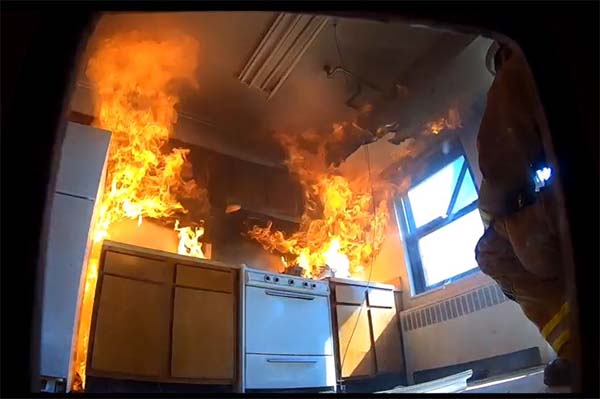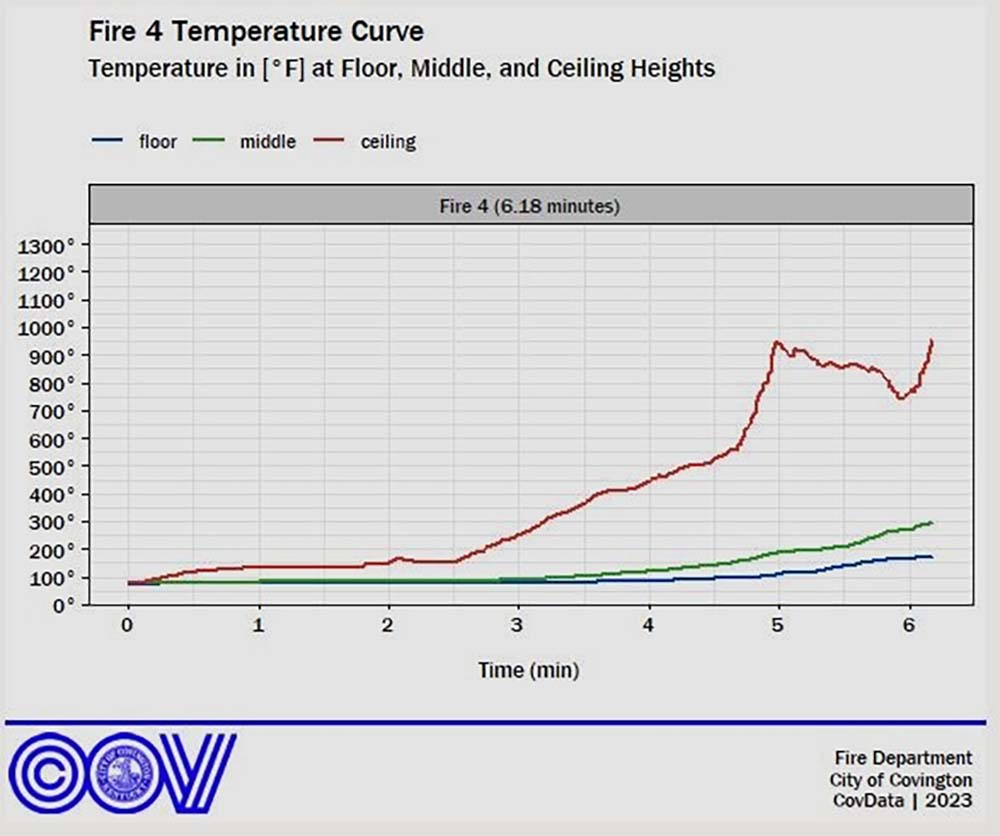The fire starts as tiny flames on the stovetop in a City Heights apartment, but its progression is scary.
By minute 2, material on the counter is ablaze, and at 2:50, so is the wooden cabinet above it. At 3:30, the drywall ceiling starts to darken from soot and, with ashes blowing through the air, so do the walls. As the flames grow higher, the plastic shield covering the fluorescent lights on the ceiling melts and drops to the floor at 4:40, and a minute or so later, the bulbs themselves release and fall.
All the while, temperature soars.
In only 5 minutes, just when smoke can be seen billowing out the open kitchen door, the temperature at ceiling level has reached an excruciating 1,000 degrees …
No one was hurt in the blaze.
It was a controlled experiment set up by the Covington Fire Department with outside partners – one of eight “burns” in five vacant apartments conducted in October in the ongoing mission of better understanding the characteristics of fire and better training firefighters to both suppress it and investigate it.
The data revealed – and the lessons learned – will be used to improve everything from response times to fire suppression to safety equipment to determining how a fire started.
Even for experienced firefighters, the lessons were impressive.
“These tests reinforced how important time is,” said Greg Salmons, Covington’s Assistant Fire Chief of Prevention and Education. “They showed how in 3 or 4 minutes, a small fire in a couch can grow to one capable of consuming the entire floor of a house.”
Meanwhile, Capt. Joseph Vance, who is assigned to Covington’s Fire Prevention Bureau, said the fires demonstrated firsthand how the changes in manufacturing increase the challenges for First Responders.
“Synthetic materials burn a lot faster and a lot hotter and produce a lot more smoke,” Vance said. “We need to stay on top of that.”
City Heights is a public housing complex at the southern end of Benton Road in Covington that is being shut down because of its unsafe and deteriorated condition. (Two years after the federal government approved that decision, only a few dozen of its 366 units are occupied.)
Ahead of the planned demolition of the complex, the Covington Fire Department received permission from the Housing Authority of Covington to conduct the burn tests inside a few of its vacant buildings on Alden Court.
Fire officials set up scenarios that simulated fires in a kitchen, living rooms, an office, and a children’s bedroom: For example, the “kitchen fire” was set on a stove, the “office fire” was set in a paper shredder, the “bedroom fire” was set with a flameless candle, and the “living room fire” included a Christmas tree, couch, and presents.
The scenarios were constructed with help from the Campbell County Fire Investigation Team, and the federal Bureau of Alcohol, Tobacco, Firearms and Explosives provided equipment to measure temperatures at ground, ceiling, and mid-room heights. Video cameras provided footage of the fires from both within the rooms and just outside.
Covington firefighters stood by to accelerate and/or suppress areas of flame to produce the most helpful results.
The benefits of the tests were many, Salmons said:
• The research data itself – including the temperature data – will add to the ongoing “science” of firefighting as firefighters continue to better understand how fires start, spread, and “act.” Todd Sink, Manager of Analytics and Intelligence at Covington City Hall, organized the temperature data into burn charts that showed the growing intensity of the fires.
• After the fires were extinguished, instructors with the International Association of Arson Investigators, which is conducting a fire investigation technician class in the region, took about 30 local fire and police personnel to the fire scenes as part of ongoing training of fire origins and burn patterns.
• Covington’s Fire Department used the fires to give real-flame experience to new recruits.
• A professional fire scene photographer also used the burned apartments to help Covington officials improve how they photograph future scenes.
• And the scenes will be used to train insurance adjusters as well.
The tests were invaluable, Covington fire officials said.
“Having the ability to use the City Heights units offered a unique opportunity,” Vance said. “We were able to create more realistic scenes in lieu of building mock rooms. The quality of training improves when you can make it as realistic as possible.”
Salmons said such research will continue.
“Fire safety is a lot more than just throwing water at flames,” he said. “As our knowledge of fire behavior expands, how we respond will likewise continue to evolve.”
City of Covington


















